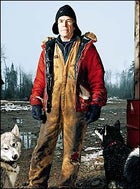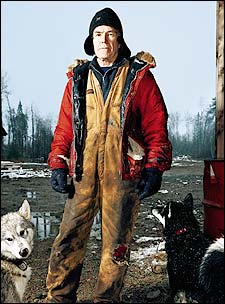ON DECEMBER 15, famed polar explorer Will Steger was set to embark on an epic new Arctic project: a seven-month, 3,000-mile dogsled journey from Yellowknife, in Canada’s Northwest Territories, to Pangnirtung, on the Atlantic coast of the nearly uninhabited Baffin Island. The Minnesota-based Steger, now 59, vaulted to prominence in 1986, when he and Paul Schurke completed the first unsupported dogsledding trip to the North Pole; four years later, Steger and an international team were the first to dogsled across the Antarctic continent. But he hasn’t led an expedition since 1997, when he abandoned a solo traverse from the North Pole to Ellesmere Island after just seven days. For this journey, Steger’s goal is to drive home the threat of climate change by filming it. His six-person team will tote DVD camcorders to remote Inuit outposts, where native people are struggling to reconcile traditional wisdom with a landscape that’s melting away.
 Polar sage Will Steger at his wilderness homestead, north of Ely, Minnesota, October 2003
Polar sage Will Steger at his wilderness homestead, north of Ely, Minnesota, October 2003
You haven’t led a major trip in six years. Are you really up for this?
It’s not like I’m coming out of mothballs. I’ve been taking smaller trips and some solos. My health is the same as when I was 18. A 3,000-mile trip in Canada is no problem at all.
Why a film project?
It’s hard to get people interested in climate change, but I can draw them in with dogs, tents, and Inuit culture. We’ll capture conversations with elders baffled by melting ice, animals disappearing—even the wind blowing from a different direction. The life balance in the Arctic is so marginal that a few degrees of temperature change can make an incredible difference.
What prompted your hiatus?
I got burnt out worrying about money and sponsorship. On my trek from the North Pole in 1997, I was so stressed on the ship ride there that I couldn’t sleep. Once on the ice, I picked up pneumonia and had to be rescued. It was like being a heavyweight boxer and losing the big match. I was ready to be out of the public eye.
But here you are, doing it all over again.
Not really. We’ve got sponsors, but this is very much a grassroots project. Most of the $300,000 budget will be paid for with T-shirt sales.
Is it a comedown to take a trip that doesn’t set any records?
In many ways, this is more of an adventure. We’ll be in areas that have never been crossed in winter. The first two months, we’ll have five to six hours of light at most, with 50-mile-per-hour winds and temperatures down to 40 below. It’s like what I used to do in the late 1970s and early 1980s, before anyone knew who I was. We would just save our money for a year and head north and see what happened.
Will this be the last hurrah?
I’ve learned never to say that, having eaten my words several times already. Plus, we’ve got the momentum going again with the dogs and a new team—it’d be a shame to sit still for a winter.


